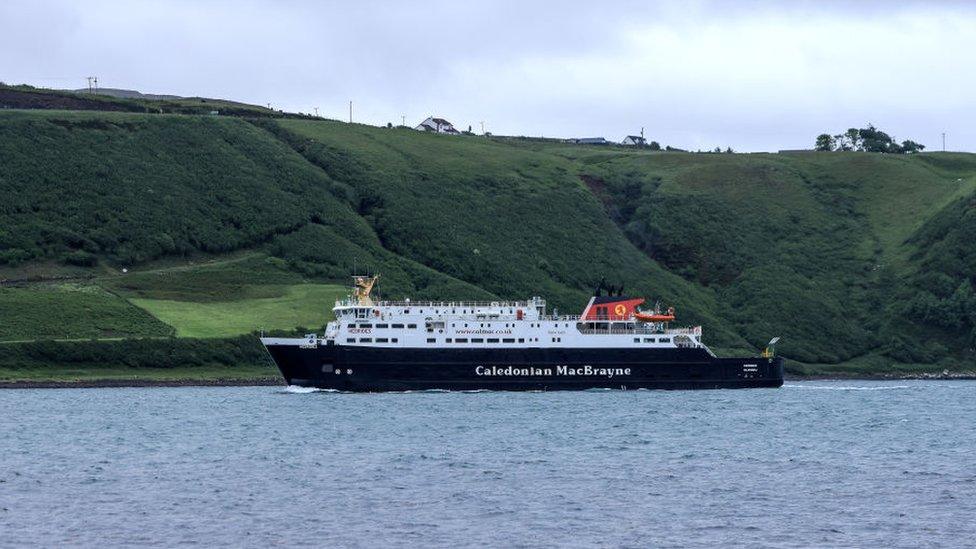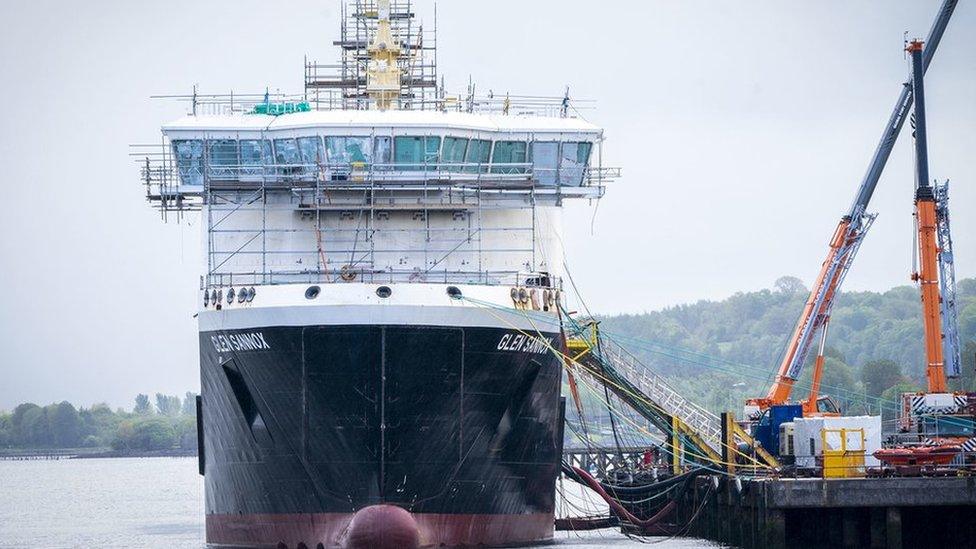£115m ferry contract for two CalMac ships for Western Isles
- Published

Two new ferries are to be ordered to help relieve pressures on west coast services operated by CalMac.
Transport Scotland said £115m had been allocated to build both ships similar to ones currently under construction for the Islay service.
The plan is to deploy the ships on the Skye triangle route and award the contract by the end of the year.
One of two other ships already being built at Ferguson shipyard in Port Glasgow will now be deployed elsewhere.
Transport Minister Jenny Gilruth said the ship known as Hull 802, which was previously planned for the Skye triangle, could potentially be used on the Arran route in the summer season.
The delayed Hull 802 would operate alongside Glen Sannox, which is also still under construction at the yard and due for delivery next year.
Scotland's ageing west coast ferry fleet, operated by state-owned CalMac, has faced increasing reliability problems and maintenance costs with several of the largest ships now beyond their expected service life.
Ms Gilruth said deploying two new ships on the Skye routes to Lochmaddy on North Uist and Tarbert on Harris would provide the island communities with "dedicated services" in the peak season.
"This will create the opportunity for significantly increased capacity and resilience for the communities of the Western Isles," she said.
"It will also allow consideration of all options to deploy Vessel 802 on an alternative route, including potentially alongside her sister ship, the MV Glen Sannox, to provide additional capacity to and from Arran in the peak season.
"All the options will be discussed with island communities at the appropriate time."


The failure to renew the West Coast fleet has been compounded by delays to Glen Sannox and Hull 802 at the Ferguson shipyard, which was nationalised in 2019 after a bitter dispute between its former owner Jim McColl and ferries agency CMAL.
The ships, which were meant to cost £97m, are five years late and could end up costing more than £300m. Mr McColl and CMAL have blamed each other for the problems.
The new ships - which could be in service by 2026 - will be based on the specification for the two vessels currently being built by a Turkish shipyard for the Islay route, and some of the £115m earmarked for them will have to be used on harbour improvement work.
Unlike the delayed ships being built at the Ferguson shipyard, which are dual fuel diesel/liquefied natural gas (LNG) vessels, the new Islay vessels are mainly diesel-powered, supplemented by battery/electric propulsion for manoeuvring in port.
It remains unclear if plans for LNG refuelling facilities as part of the Uig harbour redevelopment on Skye will now go ahead.
The plan for two new ships on the Skye triangle route were welcomed by Western Isles Council, or Comhairle nan Eilean Siar, which said it would deliver much-needed extra capacity.
Scottish Labour, however, said it would provide "cold comfort" to islanders who face many more years of waiting for replacement ferries.
Islands spokesperson Rhoda Grant said: "Scotland's islands don't have a functioning ferry network because of the SNP's failure to deliver a functioning ferry fleet, and they still have no short-term solutions and no real long-term strategy.
"Islanders will be hoping that this isn't the SNP's attempt to cook up a back-up plan in case their botched ferries never sail."
Scottish Conservative transport spokesman Graham Simpson welcomed the announcement of extra capacity, but said the ferry network problems had their origins in SNP "incompetence".
He added: "It is a relief to see the SNP finally playing catch-up on their decade-old ferry replacement programme, but after the fiasco at Ferguson Marine, no-one will be holding their breath for these vessels being delivered any time soon."


This £115m pounds of extra funding shows how ferry procurement has become a huge political problem for the Scottish government. Ministers want that to end.
CalMac's ferry fleet is ageing and overstretched, so the promise of new vessels will be a relief to island communities. The Ferguson shipyard fiasco means they've waited long enough.
But this announcement raises more questions than it answers.
Where does it leave the long-awaited Hull 802, under construction at the Ferguson yard? It looks like Transport Scotland is scrapping plans to use the dual fuel ferry on the Skye triangle.
Will the £5m plans for LNG bunkering at Uig on Skye now be abandoned? Should the vessel run on LNG at all? Transport Scotland says yes but is that now needed?
Where does all this leave existing plans to replace the ageing Calmac fleet?
Transport Scotland says the £115m bill for these new ships is new money - on top of the £580m already pledged over the next 10 years for vessel replacement.
But is it the best use of that money? Some island ferry groups argue a quicker and more cost efficient way or renewing the CalMac fleet would be with catamarans.
With this announcement, the government's various transport agencies have reaffirmed their preference for more expensive mono-hulled vessels.
What does this mean for the nationalised Ferguson shipyard on the Clyde? Will they bid for the new ferry contract? Or is their focus the contract for seven smaller vessels needed by CalMac?
And since these ferries won't be ready until 2026, is the Scottish government still planning to hire another ferry to add to the CalMac fleet? The existing vessels are over-stretched. What is being done to plug gaps left by inevitable breakdowns over the next four years?
- Published27 September 2022

- Published13 May 2022